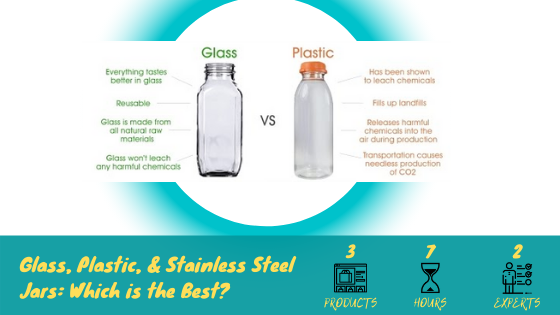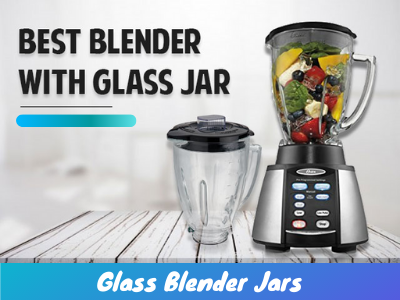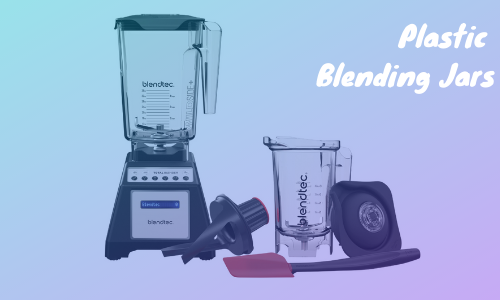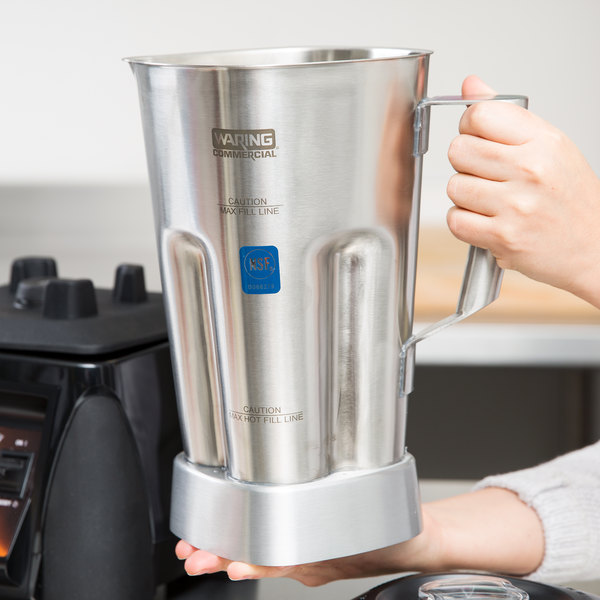Glass and plastic are two main types of blender jars. Often people overlook this detail when choosing a blender. So how does a glass vs plastic blender jar compare? Which is better for blending: plastic or glass? There are several advantages and disadvantages depending on whether the material of your blender container is plastic or glass.

While the blender container material has little impact on a blender’s power, it does in fact contribute to how well it blends. In addition, the material impacts how easy your blender is to clean. Moreover, a scratched or damaged container doesn’t blend ingredients as well. For instance, the ingredients will stick to the sides of the jar or container and not blend as well.
However, there are key differences in terms of durability, weight, clarity, ease of cleaning, clearness, and other features of your blender. Depending on the material of your blender jar, the style and look changes a lot. For many people, the final decision comes down to user preference.
Glass Blender Jars
Many blender users love the glass jar because it looks better with its vintage appeal, feels sturdier and superior to plastic, and retains its clarity overtime. For example, guests are more likely to view glass cups as high-end versus plastic cups (no matter the material).

A big reason people use glass jar blenders is because of health reasons. While most plastic jars are BPA-free, they are still plastic. A glass blending jar completely eliminates this worry.
Furthermore, a glass jar doesn’t discolor or stain as easily. Because the ingredients can’t penetrate the glass material, it simply washes away. Similarly, glass jars do not absorb odors. Glass holds up well under heat or hot ingredients. For instance, you can put a glass blending jar in the dishwasher or rinse with very hot water.
Some downsides to a glass jar blender is the expense. Furthermore, glass jar is heavy. Because of the expense and weight, glass jars have limits in terms of size and capacity. It is impossible to get a large glass blending container because it is too heavy and costly. Almost all high-end blender brands, like Blendtec and Vitamix, don’t offer glass jar containers.
Glass Jar Advantages
- Doesn’t absorb odors
- Doesn’t discolor
- Scratch resistant
- Stain resistant
- Durable
- Heat resistant
- Mostly dishwasher safe
- Healthier
Glass Jar Disadvantages
- Heavy and bulky
- Likely to break if dropped
- More expensive
- Not available on high-end blenders
Plastic Blender Jars
While its hard to ignore the benefits of glass jars, its comforting that no high-performance blenders use glass. In fact, all Vitamix and Blendtec blenders use a hardy polycarbonate plastic. Plastic is almost exclusively used in commercial blenders and preferred by chefs.
There is a large variance in terms of quality between different types of plastics. This is where it becomes confusing and why some people stick with glass jars.
For instance, budget blenders often use lower quality plastic material. Thus, these plastic containers are more likely to scratch, stain, and smell overtime. Moreover, plastic often contains BPA, which can be toxic and negatively impact peoples health.

Alternatively, high-end blenders use high quality material like polycarbonate, high-grade, or copolyester plastics. These are often heat resistant, scratch resistant, and absorb less odor.
Overall, plastic blender jars are less expensive and more easily replaceable. In addition, they are lightweight making lifting, pouring, and storing much easier. Moreover, it is easy to find high capacity plastic containers. Lastly, plastic containers are much more forgiving if dropped accidentally.
Plastic Jar Advantages
- Light weight and easier to lift
- Large capacity containers
- Less expensive
- Easier and cheaper to replace
- Less prone to shatter or break
Plastic Jar Disadvantages
- May leach chemicals
- Absorbs food odors overtime
- Scratches more easily
- Stains & discolors more easily
- Find BPA-free and make sure plastic is healthy
- May not be heat resistant
Glass vs. Plastic Blender Jar
So now that you have a better understanding of the pros and cons of glass blender jars and plastic blender jars, which is better? Here is a table that shows a comparison of glass vs. plastic blender jars.
| Area | Plastic Jar | Glass Jar |
|---|---|---|
| Light Weight | ☑ | ☒ |
| Cost | ☑ | ☒ |
| Large Capacity | ☑ | ☒ |
| Shatter Resistant | ☑ | ☒ |
| Heat Resistant | ☑☒ | ☑ |
| Scratch Resistant | ☒ | ☑ |
| Stain Resistant | ☒ | ☑ |
| Odor Resistant | ☒ | ☑ |
| Chemical Leaching | ☒ | ☑ |
| Environment | ☒ | ☑ |
| Healthier | ☒ | ☑ |
As we can see from the table, plastic blender jars are favorable over glass when it comes to lightweight, cost, large capacity, and shatter resistant. It is important to note that it greatly depends on the quality of plastic.
High quality plastic performs just as good as glass in many areas. Especially when you get into the high-end blenders like Vitamix and Blendtec. Although overtime, plastic containers are more likely to scratch from blending ice or tough ingredients.
Contrastingly, glass blender jars perform better over plastic when it comes to scratch resistance, stain resistance, odor resistance, chemical leaching, environmentally friendly, and healthier for the body overall.
At the end of the day, it comes down to what you want. There are many advantages to both plastic and glass jars as well as downsides. Only you can weigh what is important to you.
Stainless Steel Blender Jars

There is a third option which is stainless steel blender jars. A lot of mixers use stainless steel, metal containers or jars. The stainless steel gives a very sleek and modern appeal. However, stainless steel blenders cost a pretty penny. Often restaurants, cafes, and commercial establishments use stainless steel jars.
However, Waring Commercial makes stainless steel blender jars that work with Vitamix and Blendtec blenders. Moreover, it is a great alternative to a plastic container for high-end blenders because it doesn’t leach plastic or chemicals, retains the temperature of the ingredients, lightweight, and durable. In fact, many professionals prefer making cocktails, margaritas and other icy drinks using a stainless steel jar.
On the other hand, there are a few downsides like if the stainless steel jar falls it can dent. Think about stainless steel water bottles that drop and dent. Another downside is it’s not transparent. For instance, you can’t see ingredients, measurement markings, blend texture, or check progress.
Stainless Steel Jar Advantages
- Light weight
- No leaching of chemicals or food odors
- Retains temperature of ingredients
- Easy to clean & dishwasher safe
- Shatter resistant
- Durable
Stainless Steel Jar Disadvantages
- Expensive
- Prone to denting if dropped
- Not transparent or clear
- Measurement markings somewhat useless
- Not able to see texture while blending
What is the Best Blender Jar Material?
Overall, the match up between a glass vs. plastic blender jar is a toss up. First, there are many benefits and negatives to both jar types. My recommendation is to determine how you will use the blender most frequently and weigh the categories that are most important to you.
For instance, if health risks is a concern than go with the glass or stainless steel. However, if a high-end blender, like the Vitamix 750 Professional or Blendtec, is what you need, than stick with plastic or stainless steel.
Subscribe To Stumpf Studio Newsletter
By entering your email address you agree to get email updates from Stumpf Studio. We'll respect your privacy and unsubscribe at any time.
